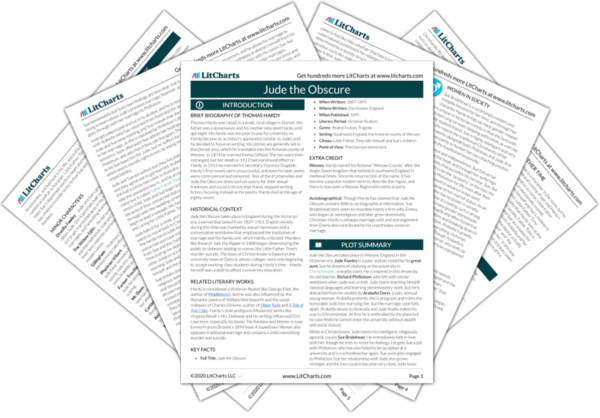Summary
Analysis
That day Jude goes out into the streets again to find Christminster looking much less romantic – “What at night had been perfect and ideal was by day the more or less defective real.” All the buildings seem pompous and decayed. Jude wanders around looking for work, and for a moment he feels that his stonework could be just as valuable as being a scholar, but then he returns to his old dream.
This sentence sums up much of the tragedy of Jude’s life – the contrast between his idealized reality and his harsh actual fate. Hardy begins his critique of the educational system. The narrator offers some external criticism, implying that Jude has over-romanticized Christminster’s intellectual life.
Themes
Jude is discouraged and asks his aunt to send the portrait of Sue. Drusilla does so, but she warns Jude not to try to find Sue. Jude decides to wait until he is more settled before finding Phillotson, whom he assumes is now a parson. Jude wanders about the colleges for days before realizing how far he still is from his dream of studying at a university. Though he shares the students’ mental life, he is still a poor working-class man who cannot afford the colleges.
As usual Drusilla acts as the voice of Hardy’s pessimism, trying to warn Jude to avoid his tragic fate but not really expecting him to do so. Jude extends his idealism to Phillotson, assuming that the schoolteacher already achieved the goal that Jude is now striving for. In his new vision of the “defective real” Jude can see reality better.
Themes
Jude finally gets a job offer from a stonemason and he accepts, deciding that his first priority should be to save up money. His aunt sends another letter warning about Sue, but Jude decides to go see Sue anyway. He learns that she works as a designer at a shop and he goes there. He watches the beautiful Sue illuminating the word “Alleluja” on a scroll, and he decides that she is innocent and saintly. Jude leaves without revealing himself.
Jude’s first perception of Sue is that she is religious and pure, though we will soon learn otherwise. He puts her on a pedestal – a common way of viewing women in Victorian times – but is also ensnared by her beauty. His fate is already sealed, as the only way to avoid it was to take Drusilla’s advice and never see Sue.
Themes
Afterwards Jude often follows Sue or seeks out her presence, but she doesn’t notice that he is there. He admires her beauty and refined nature, which he assumes she acquired in London, and wonders how one of his “almost accursed stock” could have reached such “niceness.” He begins to fall in love with her, but recognizes that they could never marry because he is already married, it is bad luck for cousins to marry, and they are both of the same family which is cursed regarding marriage. Jude resolves to think of Sue only as a cousin and friend.
Jude has taken the “curse” of the Fawleys more to heart since his own bad marriage, and because Sue is his cousin she also falls under the same curse. Jude’s tendency towards idealism is now focused on Sue, as he prefers observing and romanticizing her from afar instead of actually talking to her – like he longed for Christminster for years before actually going there.
Themes
Get the entire Jude the Obscure LitChart as a printable PDF.













